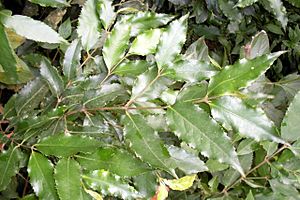Socketwood facts for kids
Quick facts for kids Socketwood |
|
|---|---|
 |
|
| Daphnadra apatela at its southern limit of distribution, on an alluvial plain at private property, Martinsville (33° S) , Australia | |
| Scientific classification | |
| Genus: |
Daphnandra
|
| Species: |
apatela
|
| Synonyms | |
|
|
Daphnandra apatela, also called the socketwood, light yellowwood, or canary socketwood, is a common tree found in the rainforests of eastern Australia. It prefers to grow in very fertile soils, like those found near rivers or on volcanic ground. This tree is found from the Watagan Mountains in New South Wales all the way north to Miriam Vale near Gladstone in Queensland.
Contents
About the Name and Family
Daphnandra apatela belongs to an ancient plant family called Atherospermataceae. This family has roots going back to the supercontinent Gondwana. For a long time, this tree was thought to be the same as another species, Daphnandra micrantha.
However, a scientist named Richard Schodde discovered it was a unique species. The name Daphnandra comes from Greek words. "Daphne" refers to the Bay Laurel tree, and "andros" means man. This name was chosen because the tree's flower parts (anthers) look similar to those of the Bay Laurel.
The species name "apatela" is also from Greek and means "to deceive." This is because the tree looks so much like Daphnandra micrantha. One special feature of this tree is how its larger small branches connect to the main trunk. They look like a "ball and socket" joint, which is why it's called Socketwood. The names Canary Socketwood or Light Yellowwood describe the light yellow color of its wood.
What the Tree Looks Like
The Daphnandra apatela is a medium to large tree. It can grow taller than 30 meters (about 100 feet) and its trunk can be up to 75 centimeters (about 30 inches) wide. Its branches spread out horizontally, forming a thick, dense top (crown).
The bottom of the tree's trunk sometimes has wide, flat parts, but it doesn't have large root supports called buttresses. The bark is grey and feels a bit rough. It has small, raised bumps that look like cork. The bark contains natural compounds. Smaller branches are covered in soft, fine hairs. Where larger small branches meet the main stem, they form a special "ball and socket" type joint.
Leaves of the Tree
The leaves of the Daphnandra apatela tree are usually 3 to 8 centimeters (1.2 to 3.1 inches) long and 1.5 to 4 centimeters (0.6 to 1.6 inches) wide. Each side of the leaf has about 20 small teeth, but the very base of the leaf does not have teeth.
The main vein (midrib) on the leaf is either flat or slightly raised on the top surface. It is more clearly raised on the underside of the leaf. You can also see 2 to 7 side veins branching off the midrib on each side. The green leaf stem is 3 to 8 millimeters (0.1 to 0.3 inches) long. The leaves grow in pairs directly opposite each other on the stem.
Flowers and Fruit
Daphnandra apatela trees produce flowers from September to October. These flowers are white and grow in small clusters called panicles. Each flower is about 8 millimeters (0.3 inches) wide and grows on a short stalk.
The fruit of the tree is a type of dry fruit called a capsule. It is covered in fine brown hairs. The fruit can be egg-shaped, round, or sometimes a bit uneven. It is usually 12 to 25 millimeters (0.5 to 1 inch) long. The fruit ripens between December and February, but sometimes as late as May. If you plant fresh seeds, about 10% of them will sprout after 24 days.
See also
 In Spanish: Daphnandra apatela para niños
In Spanish: Daphnandra apatela para niños

